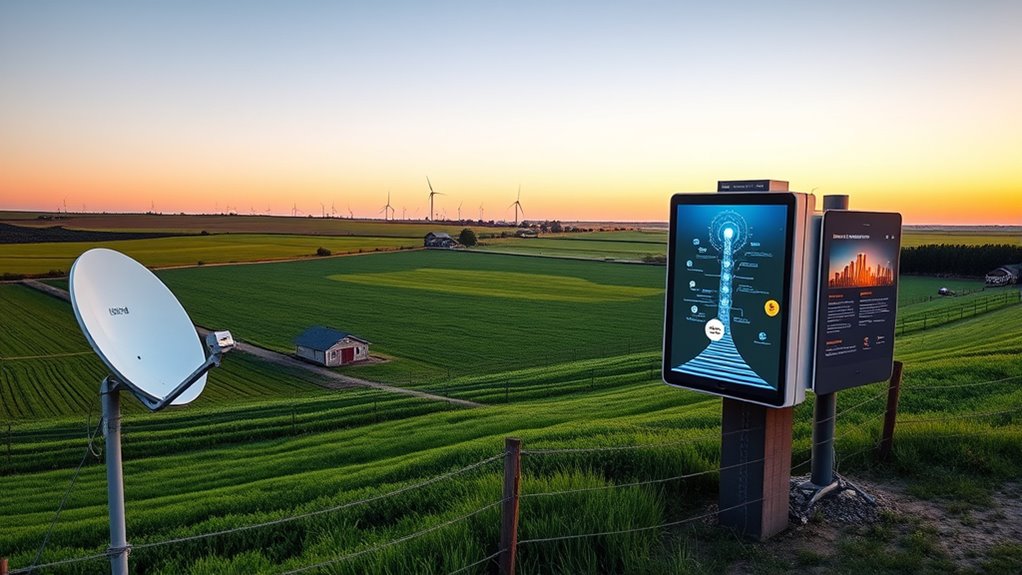The federal broadband expansion plan will transform your rural community by bringing reliable high-speed internet, closing the digital divide, and opening new opportunities for education, healthcare, and economic growth by 2030. Faster connections mean better access to online services and improved quality of life. Infrastructure investments will make your area more connected and prosperous. To discover how these changes will shape your future and what’s being done, continue exploring the full benefits of this initiative.
Key Takeaways
- Rural communities will gain reliable, high-speed internet, closing the digital divide and expanding access to essential online services.
- Enhanced connectivity will support education, healthcare, and economic growth, improving residents’ quality of life.
- Infrastructure investments will enable remote work and attract new businesses, strengthening local economies by 2030.
- Initiatives promoting inclusivity will ensure even the most isolated households and public spaces are connected.
- Overall, rural America will become more digitally integrated, fostering equity, opportunity, and community resilience.

Despite ongoing efforts, many rural communities still lack reliable high-speed internet, limiting their access to education, healthcare, and economic opportunities. This persistent digital divide hampers residents’ ability to compete in an increasingly connected world. Fortunately, the new federal broadband expansion plan aims to address this gap through significant infrastructure investment, designed to bring high-quality internet services to even the most remote areas. As these projects unfold, you can expect a transformative impact on rural America’s economy and daily life by 2030.
Many rural areas still lack reliable high-speed internet, hindering access to essential services and opportunities.
The core of this initiative is infrastructure investment, which involves deploying fiber-optic cables, expanding wireless networks, and upgrading existing internet infrastructure. This approach recognizes that simply encouraging private providers isn’t enough; substantial government funding is necessary to build the robust network needed in rural regions. When these investments are completed, you’ll notice faster, more reliable internet connections that support everything from streaming and online education to telehealth services. It’s about creating a foundation that empowers communities to thrive in the digital age.
By narrowing the digital divide, this expansion opens up new opportunities for rural residents. Education becomes more accessible, with students able to participate in virtual classes and access online resources without frustrating interruptions. Healthcare providers can offer telemedicine services, allowing you to consult specialists or receive treatment without long travel. Small businesses benefit too, gaining the ability to reach broader markets, streamline operations, and compete on a national level. This connectivity fuels local economies and helps attract new investments, creating a ripple effect of growth and stability. Additionally, improving network infrastructure helps close the digital divide, ensuring equitable access across all communities.
Moreover, the federal plan emphasizes equitable deployment, ensuring that even the most isolated households receive high-speed internet. This focus on inclusivity means that rural communities won’t be left behind as urban areas advance technologically. As infrastructure investment accelerates, you’ll likely see a surge in community centers, schools, and public spaces getting upgraded with free or affordable Wi-Fi, further bridging access gaps. Recognizing the importance of broadband infrastructure, local governments are also exploring innovative solutions like satellite technology to reach the most remote locations. Strengthening digital equity initiatives will also be crucial to ensure that all residents benefit equally from the new networks.
Looking ahead to 2030, these initiatives could redefine rural living. Access to reliable broadband isn’t just about convenience; it’s about opportunity. It can lead to improved quality of life, more educational and employment options, and stronger local economies. While challenges remain, the federal government’s commitment to infrastructure investment signals a promising future where rural America is no longer on the wrong side of the digital divide but is instead a essential part of the connected nation.
Frequently Asked Questions
How Will Broadband Expansion Impact Local Businesses in Rural Areas?
You’ll see local businesses thrive as broadband expansion boosts digital literacy and opens new opportunities. With faster internet, you can reach wider markets, streamline operations, and adopt innovative tech solutions. This growth encourages small business development, creating jobs and strengthening your community. As digital literacy improves, you and your neighbors become more competitive, ensuring your business stays relevant and grows sustainably in the digital economy.
What Are the Environmental Considerations of Deploying New Broadband Infrastructure?
When deploying new broadband infrastructure, you should consider the ecological impact and focus on sustainable infrastructure. You might use eco-friendly materials, minimize land disturbance, and avoid disrupting wildlife habitats. It is crucial to balance improved connectivity with environmental preservation, ensuring that construction practices reduce carbon footprints and protect natural resources. By prioritizing these considerations, you help promote a sustainable approach that benefits both rural communities and the environment.
How Will Funding Be Allocated Among Different Rural Communities?
While the specifics of funding distribution remain nuanced, you can expect a thoughtful approach to community prioritization. Federal agencies will focus on bridging connectivity gaps, ensuring that underserved rural areas receive targeted support. Funding will be allocated based on need, infrastructure readiness, and potential impact. This strategic prioritization aims to foster equitable growth, bringing reliable broadband access to communities that can benefit most, ultimately transforming rural life by 2030.
What Measures Ensure Equitable Access for All Rural Residents?
You can guarantee equitable access for all rural residents by promoting digital literacy and implementing affordability programs. These measures help bridge the digital divide, making internet services accessible and understandable. You should support initiatives that provide training and affordable plans, so everyone can benefit from improved broadband. By focusing on these efforts, you help create a more inclusive digital environment, ensuring no one is left behind in rural America’s connectivity advancements.
How Will Broadband Expansion Affect Existing Internet Service Providers?
The broadband expansion will revolutionize how existing providers operate, creating fierce market competition that shakes up the industry. You’ll see providers scrambling to improve service or lower prices, driven by stronger provider incentives to innovate and retain customers. This overhaul may even push smaller companies to expand their reach or face being left behind. Overall, it’s a game-changer that will challenge the status quo and reshape the internet landscape for everyone.
Conclusion
As you see the new federal broadband expansion unfold, it’s more than just faster internet—it’s a chance to connect, grow, and thrive in rural America. This effort coincides with your community’s desire for progress, showing that opportunity and resilience often arrive together. By 2030, what seems like a simple upgrade could become the turning point where your world changes quietly but forever, reminding you that sometimes, the right support arrives just when you need it most.
Amina brings over a decade of journalism experience to her role as Editor-in-Chief. Under her leadership, Exquisite Post has flourished, maintaining the highest standards of integrity and excellence. Amina’s commitment to truth and her visionary approach guide the editorial team in producing impactful news stories that resonate with our audience.










